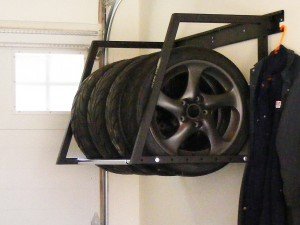It’s that time of year again; time to move your tires in and out. Of course some choose to simply store their seasonal tires at an offsite location. However, a large majority choose to store their tires at home in their garages. At the same time, there are some homeowners who choose to do both, store the set of tires for one vehicle offsite and the tires for a second or third vehicle at home in the garage. This article is for those who choose to utilize their garage space for seasonal tire storage.
 There are a few factors to consider when discussing tire storage. One of the most important issues you want to keep in mind is that of protecting the integrity of your tire. As you probably know, it is never a good idea to store the tire vertically in the same spot over an extended period of time. Storing a tire on its running surface (with or without rims) tends to leave a flat spot in your tire that may result in damage the tire.
There are a few factors to consider when discussing tire storage. One of the most important issues you want to keep in mind is that of protecting the integrity of your tire. As you probably know, it is never a good idea to store the tire vertically in the same spot over an extended period of time. Storing a tire on its running surface (with or without rims) tends to leave a flat spot in your tire that may result in damage the tire.
Another factor to consider is the weight of the tire. Obviously a seasonal tire with rims is significantly heavier than a tire without rims. Even so, the weight of a tire without rims may be a bit much for some people to hoist up to an overhead platform. You want to tailor your storage solutions to your situation, especially with bulky or heavy items such as seasonal tire.
 Tire storage options can be classified into two main categories: horizontal storage and vertical storage. Horizontal storage is exactly what it sounds like. You simply place your tires flat. The tires are either placed on a platform or they may even be stacked in the corner on the floor. Horizontal storage as an option applies to both tires with rims and tires without rims. Depending on your needs, you may decide you don’t like your tires sitting on the floor all winter and would feel much better if they were on a platform out of the way. Also remember that whatever tire storage solution you are pondering, at least moving them off of the floor frees up some more floor space for you to use.
Tire storage options can be classified into two main categories: horizontal storage and vertical storage. Horizontal storage is exactly what it sounds like. You simply place your tires flat. The tires are either placed on a platform or they may even be stacked in the corner on the floor. Horizontal storage as an option applies to both tires with rims and tires without rims. Depending on your needs, you may decide you don’t like your tires sitting on the floor all winter and would feel much better if they were on a platform out of the way. Also remember that whatever tire storage solution you are pondering, at least moving them off of the floor frees up some more floor space for you to use.
 One space-saving solution to examine if it works for your garage is that of vertical tire storage. Storing tires vertically means they are installed in a rack. The rack is then conveniently mounted in an optimum location to maximize your other storage options while still allowing access to your tires. Note that vertical storage is available both for tires with rims and for tires without rims. If you are looking around your garage and want to know if a vertical storage rack would work for you, simply take 4 times the width of your tires, which is the lateral distance or width of the rack (plus hardware needs). Then, measure the diameter of the tire, that number is the approximate depth you will need for a vertical tire storage rack. As you can see, the vertical tire storage option gets the tires out of the way in a compact and contained space.
One space-saving solution to examine if it works for your garage is that of vertical tire storage. Storing tires vertically means they are installed in a rack. The rack is then conveniently mounted in an optimum location to maximize your other storage options while still allowing access to your tires. Note that vertical storage is available both for tires with rims and for tires without rims. If you are looking around your garage and want to know if a vertical storage rack would work for you, simply take 4 times the width of your tires, which is the lateral distance or width of the rack (plus hardware needs). Then, measure the diameter of the tire, that number is the approximate depth you will need for a vertical tire storage rack. As you can see, the vertical tire storage option gets the tires out of the way in a compact and contained space.
Whichever option you choose for your seasonal tire storage needs, there is a storage solution that can fit your garage. When you decide to renovate your garage that is an excellent time to evaluate your tire storage needs and options.
